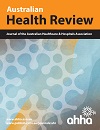AH24207Consumer involvement; the system says ‘No.’
What is known about the topic? The importance of authentic consumer engagement to shape decisions in health care is now well recognised. What does this paper add? We share our experience of working with consumers to develop strategies that aimed to optimise referrals to an evidence-based and cost-effective intervention; a pulmonary rehabilitation program. What are the implications for practitioners? Based on our experience, given their ability to navigate bureaucratic barriers within the system, future health researchers should consider actively recruiting senior hospital staff to be part of the co-design process from project inception.





